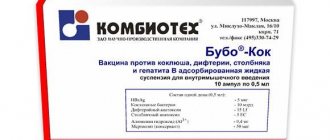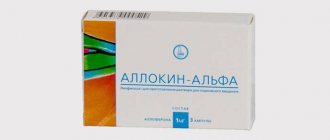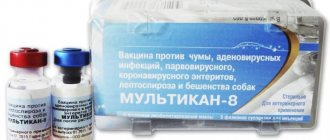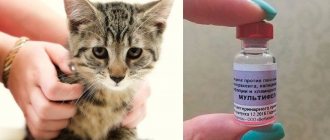Release form, packaging and composition of the drug Clinical-pharmacological group Pharmaco-therapeutic group Pharmacological action Indications for use Method of administration and doses Side effects Contraindications for use Use in children Special instructions Drug interactions
Registration Certificate Holder:
48 Central Research Institute of the Russian Ministry of Defense FGU (Russia)
ATX Code:
J07AC01
Active substance:
Dosage form:
Live anthrax vaccine
Release form, packaging and composition of the drug Live anthrax vaccine
Lyophilisate for preparing a suspension for subcutaneous administration and cutaneous scarification
in the form of a porous mass of grayish-white or yellowish-white color with a brownish tint.
| 1 amp. | |
| lyophilized suspension of live spores of the vaccine strain Bacillus anthracis STI-1 | 100 subcutaneous or 10 cutaneous vaccination doses |
Excipients
: sucrose - 10% solution (stabilizer).
Solvent composition:
30% glycerol solution.
100 subcutaneous or 10 cutaneous vaccination doses - ampoules (5) complete with solvent (1 ml amp. 5 pcs.) - cardboard packs.
Lyophilisate for preparing a suspension for subcutaneous administration and cutaneous scarification
in the form of a porous mass of grayish-white or yellowish-white color with a brownish tint.
| 1 amp. | |
| lyophilized suspension of live spores of the vaccine strain Bacillus anthracis STI-1 | 200 subcutaneous or 20 cutaneous vaccination doses |
Excipients
: sucrose - 10% solution (stabilizer).
Solvent composition:
30% glycerol solution.
200 subcutaneous or 20 cutaneous vaccination doses - ampoules (5) complete with solvent (1 ml amp. 5 pcs.) - cardboard packs.
Anthrax live vaccine
Vaccination is carried out by nursing staff under the guidance of a doctor.
Primary immunization is carried out twice by scarification with an interval of 20-30 days or subcutaneously. Revaccination is carried out once annually subcutaneously.
Vaccination according to epidemic indications is carried out subcutaneously. If necessary, revaccination is carried out once annually subcutaneously.
Vaccination by scarification (cutaneous) method
Before use, each ampoule (vial) with the vaccine is carefully inspected. The vaccine cannot be used if the integrity of the ampoule (vial) is damaged, the appearance of the dry and dissolved drug changes (the presence of foreign inclusions, unbreakable lumps and flakes), the label is missing, the expiration date has expired, or storage conditions are violated.
Based on the number of vaccination doses, the contents of the ampoule (vial) are resuspended immediately before use in a solvent - a sterile 30% aqueous solution of glycerol using a syringe with a needle for intramuscular administration (0.8x40). Add 0.5 ml to an ampoule (bottle) with 10 cutaneous doses, and 1.0 ml of solvent with 20 cutaneous doses and shake until a homogeneous suspension of grayish-white or yellowish-white color is formed. The dissolution time of the vaccine should not exceed 5 minutes. The diluted vaccine, stored under aseptic conditions, can be used within 4 hours.
The grafting is carried out on the outer surface of the middle third of the shoulder. The grafting site is treated with 70% alcohol. The use of other disinfectant solutions is not permitted. After the alcohol has evaporated, use a sterile tuberculin syringe with a thin and short needle (0.4×15), without touching the skin, apply one drop (0.025 ml) of the diluted vaccine to 2 places of future incisions at a distance of 3-4 cm on the horizontal surface of the shoulder . The skin is slightly stretched and with a sterile smallpox vaccination pen, through each drop of vaccine, 2 parallel cuts (at a distance of 3-5 mm) 10 mm long are made so that they do not bleed (blood can only appear in the form of small dewdrops). Using the flat side of a smallpox vaccination feather, rub the vaccine into the incisions for 30 seconds and allow to dry for 5-10 minutes. A separate disposable feather is used for each person being vaccinated. It is prohibited to use needles, scalpels, etc. instead of pens.
Subcutaneous vaccination
Immediately before use, the drug is resuspended in 1 ml of sterile 0.9% sodium chloride solution. The ampoule (bottle) is shaken until a uniform suspension of grayish-white or yellowish-white color is formed. The contents of the ampoule (vial) are transferred with a sterile syringe into a sterile vial with 0.9% sodium chloride solution for injection. In the case of using an ampoule (bottle) containing 200 subcutaneous vaccination doses, the suspension is transferred to a bottle with 99 ml, and containing 100 subcutaneous vaccination doses - into a bottle with 49 ml of solvent.
With the syringe method, the vaccine in a volume of 0.5 ml is injected subcutaneously into the area of the lower angle of the scapula. The skin at the injection site is treated with 70% alcohol. Before each vaccine collection, the vial is shaken. The injection site is treated with 70% alcohol.
With the needle-free method, the vaccine in a volume of 0.5 ml is administered into the area of the outer surface of the upper third of the shoulder using a needle-free injector with a protector, strictly following the instructions for its use. The vaccine injection site before and after injection is treated as with the subcutaneous method.
Unused vaccine, used vaccination disposable syringes and feathers are subject to mandatory inactivation by autoclaving at a temperature of 132±2 °C and a pressure of 2.0 kgf/m2 for 90 minutes.
Parts of the needleless injector that came into contact with the vaccine are immersed in a 6% solution of hydrogen peroxide with 0.5% detergent such as “Progress” or “Astra” for 1 hour at a temperature not lower than 50 °C. The solution is used once.
Then the injector is pre-sterilized:
a) rinsing under running water for 0.5 minutes;
b) soaking with complete immersion in a washing solution at a temperature of 50 ° C for 15 minutes. Recipe for 1 liter of washing solution: 17 g of perhydrol (27.5 g of 33% hydrogen peroxide), 5 g of detergent and 978 ml of water;
c) washing each item in a washing solution using a brush or a cotton-gauze swab for 0.5 minutes;
d) rinsing under running water for 10 minutes;
e) rinsing each item with distilled water for 0.5 minutes;
f) drying until moisture completely disappears.
Sterilization of parts of a needle-free injector is carried out by autoclaving at a temperature of 132±2 °C and a pressure of 2.0 kG/m2 for 90 minutes.
Indications for use
Specific prevention of anthrax in people over 14 years of age. Vaccination is carried out as planned and according to epidemic indications.
The following are subject to routine vaccinations:
- persons working with live cultures of the causative agent of anthrax, with infected laboratory animals, or conducting research on materials contaminated with the causative agent of anthrax;
- persons slaughtering livestock, engaged in the procurement, collection, storage, transportation, processing and sale of raw materials of animal origin;
- persons performing the following work in anthrax-enzootic areas:
- public livestock maintenance;
- agricultural, agro- and drainage, construction and other work related to the excavation and movement of soil;
- procurement, fishing, geological, survey, expedition.
Vaccination is routinely carried out in the first quarter of the year, because The most dangerous period in terms of anthrax infection in disadvantaged areas is the spring-summer season.
Directions for use and doses
Vaccination is carried out by nursing staff under the guidance of a doctor.
Routine vaccination. Primary immunization is carried out by scarification twice with an interval of 20-30 days, revaccination is carried out once annually by subcutaneous method.
Vaccination according to epidemic indications is carried out subcutaneously. If necessary, revaccination is carried out once annually subcutaneously.
Before use, each ampoule of vaccine is carefully inspected. The vaccine cannot be used if the integrity of the ampoule is damaged, the appearance of the dry and dissolved drug changes (presence of foreign inclusions, unbreakable lumps and flakes), the label is missing, the expiration date has expired, or storage conditions have been violated.
1. Vaccination by cutaneous (scarification) method.
Based on the number of vaccination doses, the contents of the ampoule (vial) are resuspended immediately before use in a solvent - a sterile 30% aqueous solution of glycerol using a syringe with a needle for intramuscular administration (No. 0840). Add 0.5 ml to an ampoule (bottle) with 10 cutaneous doses, and 1.0 ml of solvent with 20 cutaneous doses and shake until a homogeneous suspension of grayish-white or yellowish-white color with a brownish tint is formed. The dissolution time of the vaccine should not exceed 5 minutes. The diluted vaccine, stored under aseptic conditions, can be used within 4 hours.
The grafting is carried out on the outer surface of the middle third of the shoulder. The grafting site is treated with 70% alcohol. The use of other disinfectant solutions is not permitted. After the alcohol has evaporated, use a sterile tuberculin syringe with a thin and short needle (No. 0415), without touching the skin, apply one drop (0.025 ml) of the diluted vaccine to 2 places of future incisions at a distance of 3-4 cm on the horizontal surface of the shoulder. The skin is slightly stretched and with a sterile smallpox vaccination pen, through each drop of vaccine, 2 parallel cuts (at a distance of 3-5 mm) 10 mm long are made so that they do not bleed (blood can only appear in the form of small dewdrops). Using the flat side of a smallpox vaccination feather, rub the vaccine into the incisions for 30 seconds and allow to dry for 5-10 minutes. /A separate disposable feather is used for each person being vaccinated. It is prohibited to use needles, scalpels, etc. instead of pens. P.
2. Vaccination by subcutaneous method.
It is strictly forbidden to use a vaccine diluted for cutaneous use!
Immediately before use, the drug is resuspended in 1 ml of sterile sodium chloride solution of 0.9%. The ampoule (bottle) is shaken until a uniform suspension of grayish-white or yellowish-white color with a brownish tint is formed. The contents of the ampoule (vial) are transferred with a sterile syringe into a sterile vial with sodium chloride solution 0.9% for injection. If an ampoule (bottle) containing 200 subcutaneous vaccination doses is used, the suspension is transferred to a bottle with 99 ml, and one containing 100 subcutaneous vaccination doses is transferred to a bottle with 49 ml of solvent.
With the syringe method, the vaccine in a volume of 0.5 ml is injected subcutaneously into the area of the lower angle of the scapula. The skin at the injection site is treated with 70% alcohol. Before each vaccine collection, the vial is shaken. The injection site is lubricated with 5% tincture of iodine. With the needle-free method, the vaccine in a volume of 0.5 ml is administered into the area of the outer surface of the upper third of the shoulder using a needle-free injector with a protector, strictly following the instructions for their use. The vaccine injection site before and after injection is treated as with the subcutaneous method.
Unused vaccine, used vaccination disposable syringes and feathers are subject to mandatory inactivation by autoclaving at a temperature of (132+2) ° C and a pressure of 2.0 kgf/m for 90 minutes.
Parts of the needleless injector that came into contact with the vaccine are immersed in a 6% hydrogen peroxide solution with the addition of 0.5% detergent such as “Progress” or “Astra” for 1 hour at a temperature not lower than 50°C. The solution is used once. Then the injector is pre-sterilized:
a) rinsing under running water for 0.5 minutes;
b) soaking with complete immersion in a washing solution at a temperature of 50°C for 15 minutes. Recipe for 1 liter of washing solution: 17 g of perhydrol (27.5 g of 33% hydrogen peroxide), 5 g of detergent and 978 ml of water;
c) washing each item in a washing solution using a brush or a cotton-gauze swab for 0.5 minutes;
d) rinsing under running water for 10 minutes;
e) rinsing each item with distilled water for 0.5 minutes;
e) drying until moisture completely disappears.
Sterilization of parts of a needleless injector is carried out by autoclaving at a temperature of (132±2)°C and a pressure of 2.0 kGs/m2 for 90 minutes.
Live anthrax vaccine for the prevention of anthrax
Vaccination is carried out by nursing staff under the guidance of a doctor.
Routine vaccination. Primary immunization is carried out by scarification twice with an interval of 20-30 days, revaccination is carried out once annually by subcutaneous method.
Vaccination according to epidemic indications is carried out subcutaneously. If necessary, revaccination is carried out once annually subcutaneously.
Before use, each ampoule of vaccine is carefully inspected. The vaccine cannot be used if the integrity of the ampoule is damaged, the appearance of the dry and dissolved drug changes (presence of foreign inclusions, unbreakable lumps and flakes), the label is missing, the expiration date has expired, or storage conditions have been violated.
1. Vaccination by cutaneous (scarification) method.
Based on the number of vaccination doses, the contents of the ampoule (vial) are resuspended immediately before use in a solvent - a sterile 30% aqueous solution of glycerol using a syringe with a needle for intramuscular administration (No. 0840). Add 0.5 ml to an ampoule (bottle) with 10 cutaneous doses, and 1.0 ml of solvent with 20 cutaneous doses and shake until a homogeneous suspension of grayish-white or yellowish-white color with a brownish tint is formed. The dissolution time of the vaccine should not exceed 5 minutes. The diluted vaccine, stored under aseptic conditions, can be used within 4 hours.
The grafting is carried out on the outer surface of the middle third of the shoulder. The grafting site is treated with 70% alcohol. The use of other disinfectant solutions is not permitted. After the alcohol has evaporated, use a sterile tuberculin syringe with a thin and short needle (No. 0415), without touching the skin, apply one drop (0.025 ml) of the diluted vaccine to 2 places of future incisions at a distance of 3-4 cm on the horizontal surface of the shoulder. The skin is slightly stretched and with a sterile smallpox vaccination pen, through each drop of vaccine, 2 parallel cuts (at a distance of 3-5 mm) 10 mm long are made so that they do not bleed (blood can only appear in the form of small dewdrops). Using the flat side of a smallpox vaccination feather, rub the vaccine into the incisions for 30 seconds and allow to dry for 5-10 minutes. /A separate disposable feather is used for each person being vaccinated. It is prohibited to use needles, scalpels, etc. instead of pens. P.
2. Vaccination by subcutaneous method.
It is strictly forbidden to use a vaccine diluted for cutaneous use!
Immediately before use, the drug is resuspended in 1 ml of sterile sodium chloride solution of 0.9%. The ampoule (bottle) is shaken until a uniform suspension of grayish-white or yellowish-white color with a brownish tint is formed. The contents of the ampoule (vial) are transferred with a sterile syringe into a sterile vial with sodium chloride solution 0.9% for injection. If an ampoule (bottle) containing 200 subcutaneous vaccination doses is used, the suspension is transferred to a bottle with 99 ml, and one containing 100 subcutaneous vaccination doses is transferred to a bottle with 49 ml of solvent.
With the syringe method, the vaccine in a volume of 0.5 ml is injected subcutaneously into the area of the lower angle of the scapula. The skin at the injection site is treated with 70% alcohol. Before each vaccine collection, the vial is shaken. The injection site is lubricated with 5% tincture of iodine. With the needle-free method, the vaccine in a volume of 0.5 ml is administered into the area of the outer surface of the upper third of the shoulder using a needle-free injector with a protector, strictly following the instructions for their use. The vaccine injection site before and after injection is treated as with the subcutaneous method.
Unused vaccine, used vaccination disposable syringes and feathers are subject to mandatory inactivation by autoclaving at a temperature of (132+2) ° C and a pressure of 2.0 kgf/m for 90 minutes.
Parts of the needleless injector that came into contact with the vaccine are immersed in a 6% hydrogen peroxide solution with the addition of 0.5% detergent such as “Progress” or “Astra” for 1 hour at a temperature not lower than 50°C. The solution is used once. Then the injector is pre-sterilized:
a) rinsing under running water for 0.5 minutes;
b) soaking with complete immersion in a washing solution at a temperature of 50°C for 15 minutes. Recipe for 1 liter of washing solution: 17 g of perhydrol (27.5 g of 33% hydrogen peroxide), 5 g of detergent and 978 ml of water;
c) washing in a washing solution using a brush or a cotton-gauze swab
each item for 0.5 minutes;
d) rinsing under running water for 10 minutes;
e) rinsing each item with distilled water for 0.5 minutes;
e) drying until moisture completely disappears.
Sterilization of parts of a needleless injector is carried out by autoclaving at a temperature of (132±2)°C and a pressure of 2.0 kGs/m2 for 90 minutes.
Side effect
It may manifest itself in the first day after vaccination with malaise, headache and an increase in body temperature up to 38.5°C.
Reaction to introduction
Vaccine vaccinations may be accompanied by local reactions, the intensity of which depends on the individual characteristics of those vaccinated. 24-48 hours after cutaneous vaccination, hyperemia and infiltration may occur at the site of vaccine administration, followed by the formation of yellowish crusts along the incisions. 24-48 hours after subcutaneous vaccination, pain, hyperemia, and, less commonly, an infiltrate with a diameter of up to 50 mm may occur at the injection site.
Anthrax vaccine combined
Cutaneously (scarification) and subcutaneously.
It is advisable to carry out unscheduled vaccination subcutaneously.
Primary immunization is carried out twice with an interval of 20-30 days, revaccination is carried out once annually. A cutaneous dose of the vaccine is 0.05 ml (contains 500 million spores), one subcutaneous dose is 0.5 ml (50 million spores).
Cutaneously (scarification): immediately before use, the contents of the ampoule are resuspended in a sterile 30% aqueous solution of glycerol, which is added to the ampoule using a syringe with a needle for intramuscular administration. The volume of solvent is determined by the number of vaccination doses in the ampoule. Add 0.5 ml to an ampoule with 10 cutaneous doses, and 1 ml of solvent into an ampoule with 20 cutaneous doses. The ampoule is shaken until a homogeneous suspension is formed. The dissolution time of the vaccine should not exceed 5 minutes. The diluted vaccine from an opened ampoule, stored under aseptic conditions, can be used within 4 hours. Vaccination is carried out on the outer surface of the middle third of the shoulder. The vaccination site is treated with ethanol or a mixture of ethanol and ether. The use of other disinfectant solutions is not permitted. After the ethanol and ether have evaporated, use a sterile tuberculin syringe with a thin and short needle (N 0415), without touching the skin, apply one drop (0.025 ml) of the diluted vaccine to 2 places of future incisions at a distance of 3-4 cm. The skin is slightly stretched and sterile Using a smallpox vaccination pen, 2 parallel cuts 10 mm long are made through each drop of vaccine so that they do not bleed (blood should appear only in the form of small ones). Using the flat side of a smallpox vaccination feather, rub the vaccine into the incisions for 30 seconds and allow to dry for 5-10 minutes. A separate disposable feather is used for each person being vaccinated. It is prohibited to use needles, scalpels, etc. instead of pens.
S.C.: Immediately before use, the vaccine is resuspended in 1 ml of a sterile 0.9% NaCl solution. The ampoule is shaken until a uniform suspension is formed. The contents of the ampoule are transferred with a sterile syringe into a sterile vial with 0.9% NaCl solution. In the case of using an ampoule containing 200 subcutaneous vaccination doses, the suspension is transferred to a bottle with 99 ml, and an ampoule containing 100 subcutaneous vaccination doses - into a bottle with 49 ml of solvent.
With the syringe method, the vaccine is injected into the area of the lower corner of the scapula in a dose of 0.5 ml. The skin at the injection site is treated with ethanol or a mixture of ethanol and ether. A disposable syringe and needle are used for each person vaccinated. Before each vaccine collection, the vial is shaken. The injection site is lubricated with 5% tincture of iodine.
When using the vaccine subcutaneously using the needle-free method, the vaccine is administered in a volume of 0.5 ml into the area of the outer surface of the upper third of the arm using a needle-free injector with a protector, strictly following the instructions for their use.
The vaccine injection site is treated before and after injection, as with the syringe method.
Contraindications for use
- acute infectious and non-infectious diseases - vaccinations are carried out no earlier than 1 month after recovery (remission);
- primary and secondary immunodeficiencies. When treating with steroids, antimetabolites, or radiotherapy, vaccinations are carried out no earlier than 6 months after the end of therapy;
- malignant neoplasms and malignant blood diseases;
- systemic connective tissue diseases;
- common recurrent skin diseases;
- diseases of the endocrine system;
- pregnancy and lactation;
In each individual case, for diseases not included in this list, vaccination is carried out only with the permission of the relevant medical specialist.
In order to identify contraindications, the doctor (paramedic) on the day of vaccination conducts a survey and examination of the vaccinated with mandatory thermometry.





